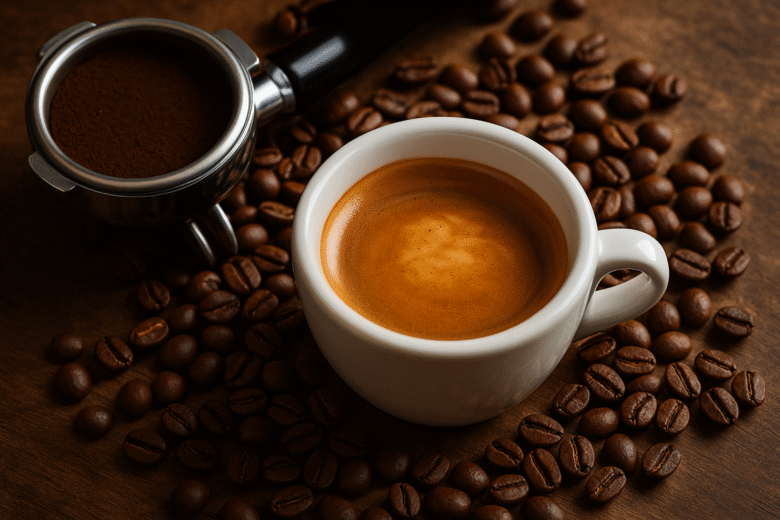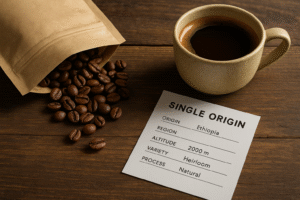Espresso is more than just a brewing method—it’s a concentrated, bold expression of a coffee bean’s essence.
But not all beans perform equally well under the intense pressure and speed of espresso extraction. To get a rich, balanced, and satisfying shot, choosing the right coffee type is crucial.
In this article, we’ll explore what makes a great espresso bean, how different origins and roast levels influence the flavor, and which specific types of coffee are best suited for espresso lovers—whether you like your shots straight, in a latte, or as part of a specialty drink.
What Makes Coffee Good for Espresso?
Espresso brewing involves forcing hot water through finely ground coffee at high pressure (typically 9 bars). This extracts flavor, aroma, oils, and body in a matter of seconds. The process demands beans that can withstand pressure and still deliver complexity.
Great espresso beans offer:
- Body: a creamy, rich texture
- Balance: a harmony of sweetness, acidity, and bitterness
- Crema: a dense, golden foam on top of the shot
- Solubility: enough oils and sugars to extract flavor quickly
These qualities depend on the coffee’s variety, origin, processing method, and roast level.
Roast Level and Espresso
Roast plays a huge role in espresso performance. While you can technically pull espresso with any roast, certain levels work better depending on your preferences and equipment.
Medium-Dark to Dark Roast:
- Most common for espresso
- Brings out chocolate, caramel, and nutty flavors
- Low acidity and heavy body
- Easier to dial in and forgiving in extraction
- Great for milk-based drinks like lattes and cappuccinos
Medium Roast:
- Offers a balance of origin flavor and roast character
- Brighter acidity and more complexity
- Better for straight espresso and specialty shots
- May require more precision in grind and temperature
Light Roast:
- Rarely used for espresso unless in specialty cafés
- High acidity, more origin expression
- Difficult to extract evenly
- Suitable for advanced home baristas using pressure profiling or long pre-infusions
For most home setups, medium-dark is the sweet spot—rich, smooth, and easy to work with.
Arabica vs. Robusta for Espresso
Espresso blends often use a mix of Arabica and Robusta beans.
Arabica:
- Sweeter, more aromatic
- Higher acidity, smoother finish
- Less crema and less caffeine
- Great for single-origin or high-end espresso
Robusta:
- Stronger, more bitter
- More crema and caffeine
- Earthier flavor and fuller body
- Common in Italian-style espresso blends
A common espresso blend ratio is 80% Arabica / 20% Robusta, giving a balance of flavor and crema. Pure Arabica is preferred for flavor-focused espresso. Robusta adds punch and texture, especially in milk drinks.
Best Origins for Espresso
Certain coffee-growing regions produce beans with ideal characteristics for espresso:
Brazil
- Smooth, nutty, chocolatey
- Low acidity and full body
- Ideal base for espresso blends
Colombia
- Sweet, well-rounded
- Balanced acidity and caramel notes
- Excellent for both blends and single-origin espresso
Ethiopia (washed or natural)
- Fruity, floral, complex
- Best for adventurous single-origin espresso
- Use medium roasts for balance and clarity
Guatemala
- Cocoa, spice, citrus
- Good body and structure
- Popular in artisan espresso blends
Sumatra
- Earthy, herbal, rich body
- Excellent for bold, dark espresso
- Often used in darker blends
India
- Spicy, low acidity, robust
- Common source of high-quality Robusta
- Helps create deep crema and rich texture
Each origin offers unique notes that can shine alone or complement other beans in a blend.
Best Processing Methods for Espresso
Processing method affects the bean’s solubility, flavor clarity, and body.
Washed (wet):
- Clean, bright, and crisp
- Good for single-origin espresso
- Easy to extract clearly
Natural (dry):
- Fruity, heavy-bodied
- Adds sweetness and texture
- Can be tricky to dial in
Honey or pulped natural:
- Combines fruitiness and clarity
- Great for espresso with sweetness and balanced acidity
- Common in Costa Rica and El Salvador
Many specialty espresso blends now incorporate a mix of these processing methods for complexity and depth.
Single-Origin vs. Espresso Blends
Espresso blends are crafted to achieve consistency, body, and balanced flavor.
Benefits of blends:
- Designed specifically for espresso
- Reliable performance with milk
- Easier to dial in and repeat
Benefits of single-origin:
- Showcases the bean’s unique character
- Often brighter and more expressive
- Ideal for black espresso or slow sips
If you’re new to espresso, blends offer a smooth entry point. If you’re chasing complexity, single-origin opens up a world of flavor possibilities.
Great Coffee Types by Roast Preference
Here’s a guide to coffee types that perform well by roast level:
Dark Roast Espresso Lovers:
- Brazilian Cerrado
- Sumatran Mandheling
- Italian-style blends with Robusta
- Indian Monsooned Malabar
Medium-Dark Roast Fans:
- Colombian Supremo
- Guatemalan Antigua
- Costa Rican Tarrazu
- Ethiopian Natural
Medium Roast Explorers:
- Kenyan AA
- Ethiopian Yirgacheffe (washed)
- Panamanian Geisha (high-end)
- Rwandan Bourbon
Try different types to see how roast interacts with origin. You may find a medium roast Colombian more satisfying than a dark roast blend, depending on your palate.
Tips for Brewing Great Espresso at Home
- Use fresh, evenly roasted beans. Espresso is unforgiving to staleness.
- Grind fine and adjust gradually. Espresso grind is finer than drip or pour-over.
- Dose accurately. Use a scale for both input (coffee) and output (espresso).
- Watch your extraction time. Aim for 25–30 seconds for most shots.
- Use filtered water. Poor water affects taste and machine health.
- Purge and clean your machine. Residue affects flavor and crema.
- Dial in with milk. If you drink lattes or cappuccinos, test how the coffee performs with steamed milk.
Experiment with beans and methods to find what suits your espresso style.
Espresso for Milk-Based Drinks
If you love lattes, cappuccinos, or flat whites, choose beans that hold up against milk. Look for:
- Bold flavor (dark chocolate, nut, spice)
- Low to medium acidity
- Medium to dark roast
- Full body and robust aftertaste
Brazilian or Sumatran-based blends work especially well. Robusta can also help retain flavor in larger milk drinks.
Fruity or floral single-origins might get lost in milk but can be excellent in cortados or straight espresso.
Conclusion: The Right Bean Makes All the Difference
Espresso magnifies the character of the coffee you use. Choosing the right type of bean—whether it’s a classic Brazilian blend or a bright Ethiopian single-origin—shapes your shot’s flavor, aroma, and texture.
Experiment across origins, roasts, and blends until you find the perfect match. With the right beans, your home espresso can rival any café—and offer a rich, satisfying ritual every day.

Marcio Luzardo is a coffee enthusiast and the voice behind Tudo Viraliza. With a passion for turning curiosity into practical knowledge, he shares easy-to-follow tips, guides, and insights to help readers enjoy better coffee every day. When he’s not writing, Marcio is exploring new brewing methods or diving into the rich stories that connect coffee to culture, lifestyle, and wellness.



